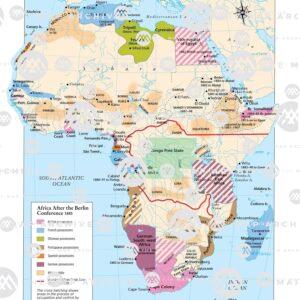The Cold War, spanning roughly from the end of World War II in 1945 to the early 1990s, was a geopolitical, ideological, and military standoff between the United States and the Soviet Union. It was a time of intense political tension, proxy conflicts, and nuclear brinkmanship that profoundly shaped the global landscape for decades to come. This period of hostility, though never erupting into a full-scale war between the superpowers, had a profound impact on world politics, culture, and society. In this 1000-word article, we will explore the origins, key events, and consequences of the Cold War, and how it defined an era.
Origins of the Cold War
The roots of the Cold War can be traced back to the end of World War II when the United States and the Soviet Union emerged as the world’s two superpowers. Although they were allies during the war, their respective ideologies and geopolitical interests were fundamentally at odds. The United States, a democratic capitalist nation, believed in individual freedoms, free markets, and liberal democracy. The Soviet Union, on the other hand, was a communist state that advocated for the spread of communism and a planned economy.
The post-war power vacuum in Europe further fueled the rivalry. As the Soviet Red Army advanced westward into Eastern Europe, it occupied and established pro-Soviet governments in several countries, creating a buffer zone between the USSR and Western Europe. This alarmed the United States and its Western allies, leading to a growing distrust between the two sides.
Key Events of the Cold War
- The Truman Doctrine (1947): President Harry S. Truman’s doctrine marked the official beginning of American containment policy against the spread of communism. The United States pledged support to any nation threatened by communism, leading to substantial economic and military aid to countries such as Greece and Turkey.
- The Marshall Plan (1948): To rebuild Western Europe and contain communism, the United States introduced the Marshall Plan. This plan provided billions of dollars in aid to war-torn European countries, helping to stabilize economies and reinforce democratic governments.
- The Berlin Airlift (1948-1949): When the Soviet Union blockaded West Berlin, the U.S. and its allies organized a massive airlift to supply the city. This event highlighted the commitment of the Western powers to protect their interests and maintain the independence of West Berlin.
- Formation of NATO (1949): The North Atlantic Treaty Organization (NATO) was established as a military alliance among Western nations to counter the Soviet threat. An attack on one member was considered an attack on all, further escalating tensions.
- Korean War (1950-1953): The Korean War was one of the first major proxy conflicts of the Cold War. North Korea, supported by the USSR and China, invaded South Korea, backed by the United States and its allies. The war ended in a stalemate, with Korea remaining divided along the 38th parallel.
- Cuban Missile Crisis (1962): The closest the world came to nuclear war during the Cold War, the Cuban Missile Crisis unfolded when the U.S. discovered Soviet nuclear missiles in Cuba. The standoff was resolved peacefully, but it emphasized the constant danger of nuclear confrontation.
- Vietnam War (1955-1975): The Vietnam War was another significant proxy conflict between the U.S. and the Soviet Union. The U.S. supported South Vietnam, while the North received aid from the USSR and China. The war ended with the reunification of Vietnam under communist control.
Consequences of the Cold War
The Cold War had far-reaching consequences that impacted various aspects of global politics, culture, and society.
- Arms Race: The United States and the Soviet Union engaged in a nuclear arms race, developing increasingly powerful and numerous nuclear weapons. This created a constant fear of a nuclear holocaust and a policy of Mutually Assured Destruction (MAD), which contributed to stability but also increased the risks.
- Space Race: The Cold War fueled the Space Race, with both superpowers striving to outdo each other in space exploration. The competition led to significant advancements in science and technology and culminated in the 1969 moon landing.
- Proxy Wars: Numerous proxy wars were fought across the globe, from Southeast Asia to Central America, as the superpowers sought to extend their influence. These conflicts left a trail of destruction and instability.
- Globalization of Conflict: The Cold War transformed localized conflicts into global concerns. Any regional dispute had the potential to escalate into a superpower showdown, making it difficult to resolve crises peacefully.
- Impact on Culture and Society: The ideological struggle between capitalism and communism influenced art, literature, cinema, and education. McCarthyism in the U.S. and censorship in the Soviet Union stifled freedom of expression.
- End of the Cold War: The Cold War eventually came to an end in the late 1980s and early 1990s. A combination of factors, including economic troubles in the USSR, the reformist leadership of Mikhail Gorbachev, and the crumbling of the Eastern Bloc, led to the peaceful dissolution of the Soviet Union in 1991.
- Legacy: The end of the Cold War reshaped the world order. The United States emerged as the sole superpower, and the era of bipolarity gave way to a unipolar world, albeit one with new challenges and conflicts.
Conclusion
The Cold War was a defining period in modern history, marked by intense ideological and geopolitical competition between the United States and the Soviet Union. It shaped the post-World War II world, influencing everything from military strategy to pop culture. The consequences of the Cold War continue to reverberate in International relations, global security, and the memory of a time when the world teetered on the brink of nuclear catastrophe. Understanding the Cold War is essential for comprehending the complex geopolitical landscape of the 20th century and its enduring effects on the 21st century.
Exploring the Battlegrounds: American Revolutionary War Maps from TheMapArchive

















































































































































































